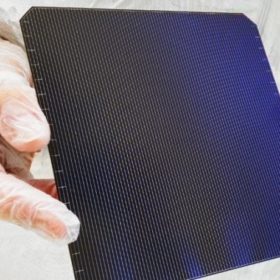
The California Institute of Technology (Caltech) has certified the efficiency of the cell, which was made with a standard M2 wafer.
Enel Green Power, the renewables unit of Italian utility Enel, and the National Solar Energy Institute (INES) – an arm of the French Alternative Energies and Atomic Energy Commission (CEA) – have achieved an efficiency of 25.0% for a heterojunction solar cell with an active surface of 213 cm2, based on the M2 silicon wafer format.
With this new result, the two parties have improved upon their previous record of 24.63%, reached last February.
The results, certified by the California Institute of Technology (Caltech), are in line with the techbroadmap developed in partnership between Enel Green Power and CEA. In response to pv magazine‘s request for more information, a CEA spokesperson said it is following the development roadmap “by constantly improving the recipes that are implemented on our industrial pilot line.” The spokesperson added that “the equipment used is industrial, a guarantee of maturity,” but did not provide any additional details.
INES and Enel Green Power have said that they will present their developments at the next EU PVSEC trade fair in September.
In February, Enel Green Power said the bifacial cell’s front-side efficiency was improved by around 0.7% by using an improved busbar-free screen printing metallization process. The method was based on heterojunction processes developed between Enel and INES, using manufacturing equipment provided by Switzerland’s Meyer Burger.
Enel said the efficiency increase was made possible by combining busbar-less technology – which enables more light to fall onto the cell surface – and a treatment developed by INES and Enel that further improved cell passivation. “The process also requires less silver and is becoming cheaper,” the spokesperson said.
In December, the new energy technologies and nanomaterials (Liten) branch of the French Alternative Energies and Atomic Energy Commission said it had achieved 24.25% peak efficiency for a silicon heterojunction solar cell. In August, troubled Chinese manufacturer Hanergy set a new efficiency record for a silicon heterojunction module at 24.85%, edging out the previous record of 24.5%, held by Kaneka. The Japanese company still holds the record for heterojunction cell efficiency, at 26.7%, on a slightly smaller device.
Lắp đặt điện mặt trời Khải Minh Tech
https://ift.tt/2X7bF6x
0906633505
info.khaiminhtech@gmail.com
80/39 Trần Quang Diệu, Phường 14, Quận 3
Lắp đặt điện mặt trời Khải Minh Tech
https://ift.tt/2ZH4TRU
Không có nhận xét nào:
Đăng nhận xét